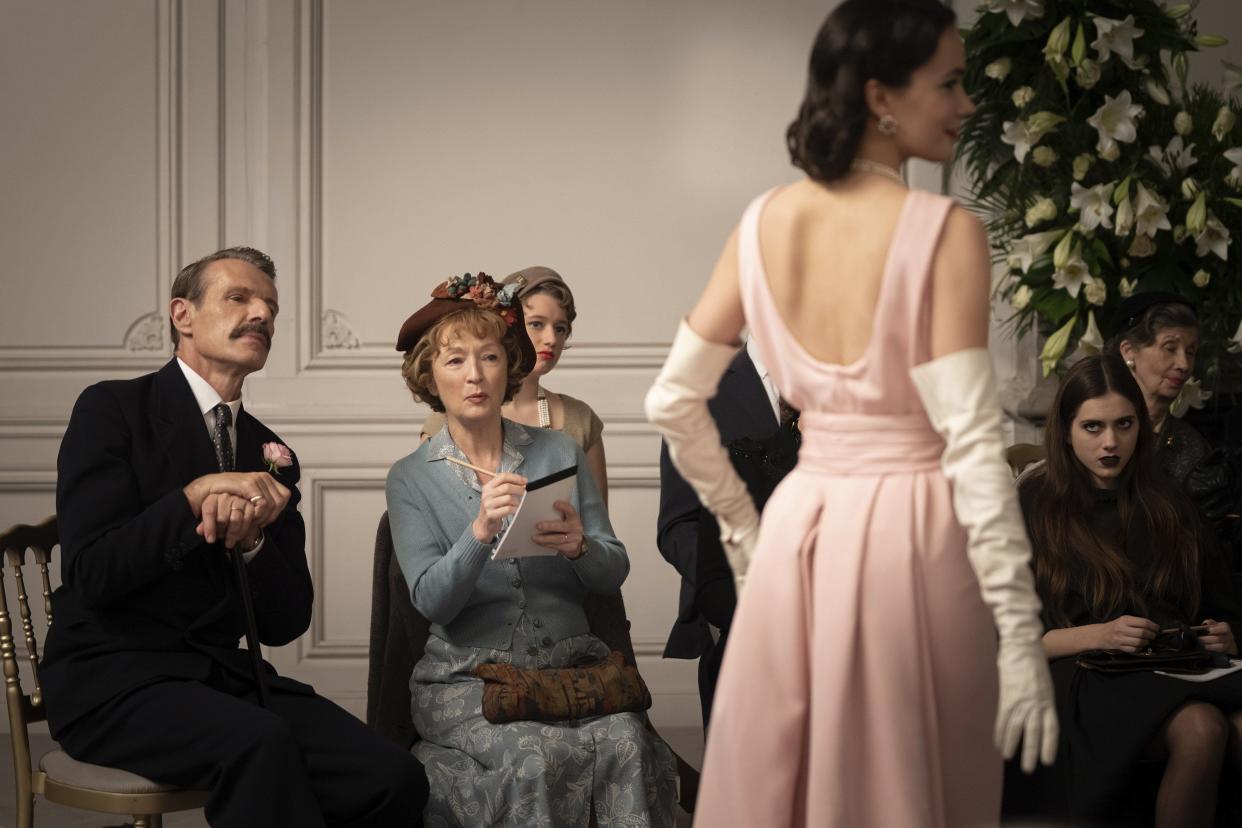Fashion is a passion in 'Mrs. Harris Goes to Paris'

- Oops!Something went wrong.Please try again later.
“Mrs. Harris Goes to Paris” wears fairy-tale ambitions on its finely-tailored sleeves.
The film, adapted from a novel by Paul Gallico and adding an “H” to the title in the process, shows a woman who's seemingly unlucky in life but for whom fate keeps smiling. Almost as though something magical is afoot.
This is more than a riff on “Cinderella,” for which you can spot multiple references. It is a feast of fashion; a film bathing in the stylistic decadence of post-war Europe and presenting the adoration of threads as an optic aphrodisiac.
It's Britain in 1957. Director and co-writer Anthony Fabian dwells quite a bit of the first act on the pains of post-war Europe. Ada Harris (Lesley Manville) cleans up after the wealthy. Some of her clients are nice enough; all are self-obsessed and vain.
Mrs. Harris spots a Christian Dior frock neglected on a bedroom seat and it is love at first sight. The audience knows this because we get the “Hitchcock zoom” where the camera dollies back while the lens zooms in. You’ve seen this before, and it’s designed to express extreme internal emotion.
Mrs. Harris knows what she wants. But how to get it? While she is poor in pocket, our titular character is rich in opportunity. She raises funds to travel to the House of Dior and pick out her dream dress for an upcoming social. She’s only got a day before she has to jet back over the channel.
Although, we know these French don’t we, folks? They will make this a challenge.
More: True/False names 'Million Dollar Pigeons' this year's Boone Dawdle film
Snootier and ruder than even the fools Mrs. Harris suffers in Britain, they cannot believe this “peasant-looking woman” could afford a Dior. This gaggle of villains is led by Claudine Colbert, as played by Isabelle Huppert. One of world cinema’s most complicated performers, it’s depressing seeing her character defined with a stuck-up nose. Huppert finds ways to bring depth to a one-dimensional character, but it’s usually through a sourpuss.
But Colbert is no match for Mrs. Harris, whom the seamstresses and some well-placed patrons take an immediate liking to. This being a fairytale, conflicts are easily resolved. But it does require our heroine to stay in Paris for another week, where she falls for a wealthy widower and befriends some younger staff members of Dior — Mrs. Harris teaches them well-worn ways of the world. Everyone learns a few life lessons, including our titular hero.
While romance abounds in the City of Love, “Mrs. Harris” never loses focus on the true object of affection: those dresses. One particular montage shows models on a walkway. Our Mrs. Harris reaches a level of manic euphoria as images hit the screen in a way that suggests something from PG-rated pornography.
Some might bellyache that a film centering around some stitching and fabric is overly materialistic. That the film equates a better way of life with a symbol of wealth.
More: First-half faves like 'Petite Maman,' 'Everything Everywhere' bode well for 2022 in film
To which I say: of course it is a symbol. The dress is a beaming ray of light in a sea of clouds. As Europe transformed from the destruction of World War II, there were questions about what the continent would look like after it rebuilt. Would people’s lives go back to normal? Culture and fashion obviously play a role in that.
As Ada walks to the House of Dior, she must navigate piles of trash that have accumulated as the result of a garbage strike. That’s a powerful image. A working-class British woman walking through French rubbish as she walks to a designer clothing store.
Mrs. Harris may say it’s her dream, her fantasy or whatever, but the dress is an ideal of what the average person could expect in the uncertainty of the modern world.
There’s also an interesting aside in the third act of “Mrs. Harris” where Dior itself goes through an existential question: how to serve customers who expected goods to come to them rather than the other way around; something that seemed antithetical to the experience of luxurious clothing.
Alas, it is just an aside as “Mrs. Harris Goes to Paris” is more focused on the fantastical elements of its story. About the good luck that befalls Ada just as the plot requires a jump start. There’s plenty of provocative ideas going on with the quest for the mythical dress — I failed to mention how Mrs. Harris’ social life is populated with West Indian immigrants — but one has to pay close attention to find them.
Manville struggles a bit in the lead role. She’s a great character actor; I couldn’t help but think of her performance in another fashioned-centered flick, “Phantom Thread,” while watching. Ada Harris doesn’t play to her strengths of exaggerating character quirks.
Regardless, there’s an audience out there who will find “Mrs. Harris Goes to Paris” a nice escape. An audience who care not about cliches or tropes, but just wants to watch an average person turn into someone more ravishing while maintaining their humility. They won’t mind that better material gets sacrificed as a result.
"Mrs. Harris Goes to Paris" opens at Ragtag Cinema Friday.
In real life, James Owen is a lawyer and executive director of energy policy group Renew Missouri. He created/wrote for Filmsnobs.com from 2001-2007 before an extended stint as an on-air film critic for KY3, the NBC affiliate in Springfield. He was named a Top 20 Artist under the Age of 30 by The Kansas City Star when he was much younger than he is now.
This article originally appeared on Columbia Daily Tribune: Fashion is a passion in 'Mrs. Harris Goes to Paris'

